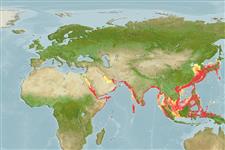Preferred temperature (Ref.
115969): 11.6 - 23.2, mean 17.4 (based on 401 cells).
Phylogenetic diversity index (Ref.
82804): PD
50 = 0.6250 [Uniqueness, from 0.5 = low to 2.0 = high].
Bayesian length-weight: a=0.00437 (0.00171 - 0.01116), b=3.07 (2.85 - 3.29), in cm Total Length, based on LWR estimates for this (Sub)family-body shape (Ref.
93245).
Trofisk nivå (Ref.
69278): 4.4 ±0.67 se; based on food items.
Resiliens (Ref.
120179): Mellan, lägsta populationsfördubblingstid 1,4-4,4 år (Tmax=15; K=0.19-0.33; Min Rel Fec=153).
Prior r = 0.57, 95% CL = 0.37 - 0.85, Based on 3 data-limited stock assessments.
Fishing Vulnerability (Ref.
59153): High vulnerability (62 of 100).
Climate Vulnerability (Ref.
125649): Very high vulnerability (85 of 100).
